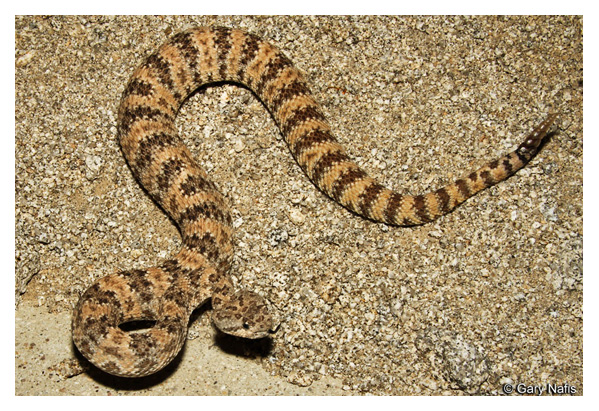Southwestern Speckled Rattlesnake

Photo - Gary Nafis - CaliforniaHerps.com
Crotalus mitchellii pyrrhus
Family: Viperidae Order: Squamata Class: Reptilia
DISTRIBUTION, ABUNDANCE, AND SEASONALITY
The speckled rattlesnake is widely distributed throughout the Colorado and Mojave deserts
and north just into the Great Basin. It is also found in the mountains and coastal-facing
canyons of San Diego, Riverside and Orange cos. It occurs from 300 to 2200 m (1000 to
7300 ft) in elevation. It prefers rocky areas and slopes in a wide variety of desert and
chaparral habitats, and occasionally in
pine-juniper,
valley-foothill woodland and
conifer habitats. This
snake is rarely encountered in large numbers and is probably uncommon in
most habitats. It is active from mid-spring to mid-fall. Higher-elevation populations become
active later in the Year (Klauber 1936, 1972, Stebbins 1954).
SPECIFIC HABITAT REQUIREMENTS
Feeding: This snake feeds on rats Dipodomys, mice (Peromyscus, Perognathus, etc.),
ground squirrels
and other
small mammals,
lizards
(Uta stansburiana, Cnemidophorus tigris
and Eumeces skiltonianus) and
birds. It
waits for
prey
to come within striking distance and
also searches actively in rocky areas (Klauber 1936, 1972, Stebbins 1954).
Cover: Often found in association with rocky areas, canyons, steep hillsides and other
areas offering rocky cover as well as dense vegetation. Rock formations, vegetation, and
mammal burrows are used for cover (Klauber 1936, 1972, Stebbins 1954).
Reproduction: Young are live-born and require a quiet, safe place for birth, such as under
or within rock formations, thick vegetation or in burrows.
Water: Probably not required.
Pattern: This snake occurs in a wide variety of habitats over a wide elevational range from
near the coast to desert mountain areas. It is most frequently encountered in hilly or
mountainous areas that are dominated by scattered rocks or larger rock formations that
provide shelter (Klauber 1936, 1972, Stebbins 1954).
SPECIES LIFE HISTORY
Activity Patterns: This snake is
diurnal
early in the season when temperatures are mild,
and becomes progressively more nocturnal as daytime temperatures increase. It becomes
active in mid-spring (later at higher elevations) and remains active until mid-fall (Klauber 1936,
1972, Stebbins 1954).
Seasonal Movements/Migration: This species is not known to migrate in California, but
rattlesnakes in cold climates, including some of the high-elevation populations of this species,
are known to move considerable distances to winter hibernacula (Klauber 1972).
Home Range: No data.
Territory: No data.
Reproduction: This snake copulates in mid-spring, shortly after becoming active. The
young are born in mid-summer. Litters average 4 young and range from 3-5 (Klauber 1936,
1972, Stebbins 1954).
Niche: There is one report of a gray fox eating a speckled rattlesnake. It is probably taken
by other mammalian predators, roadrunners, other avian predators, and kingsnakes. This
snake is sympatric with several species of rattlesnakes and may compete with them for
resources.
Riparian Habitat of Grand Canyon Wildlife
Six rattlesnake species have been recorded in the park. Two are species rarely encountered, the South-western speckled rattlesnake and the Northern ...
Joshua Tree National Park Wildlife
Southwestern Speckled Rattlesnake Crotalus mitchelli pyrrhus Rocky slopes, canyons, rock outcrops (common) Red Diamond Rattlesnake Crotalus ruber ruber ...
Grand Canyon Wildlife - Reptiles
Six rattlesnake species have been recorded in the park. Two are species rarely encountered, the South-western speckled rattlesnake and the Northern ...
Source:
CDFW California Wildlife Habitat Relationships. Accessed [N/A]
https://wildlife.ca.gov/Data/CWHR
Size: 21.6-39.4 in (55-100 cm)
Distinguishing characters: A rattlesnake with highly variable dorsal coloration- white to dark grey or shades of pink or orange; dark, diffused bands on back often split by lighter color; keeled scales; large head; salt-and-pepper speckles over entire dorsal pattern; tail with black and white bands, often incompletely encircling tail.
Juveniles: Similar to adults.
Similar species: Crotalus ruber: Has distinct diamond pattern on dorsum; black and white tail bands completely encircle tail. Crotalus viridis: Has diamond pattern on dorsum; prominent eye stripe; lacks black and white tail bands.
Additional notes: An alert, nervous species most often associated with rocky hillsides and outcrops. VENOMOUS; don't handle or use extreme caution.